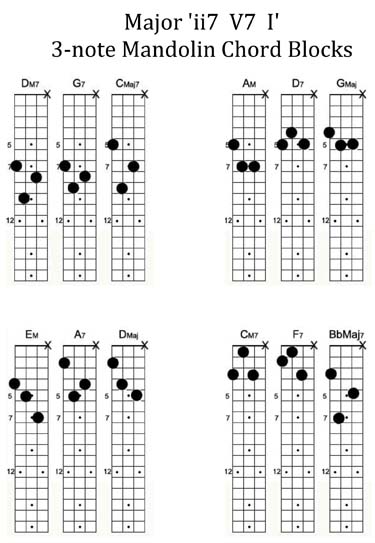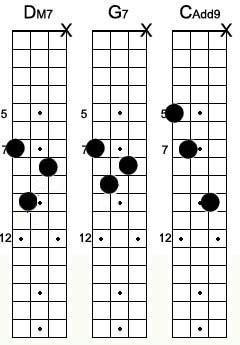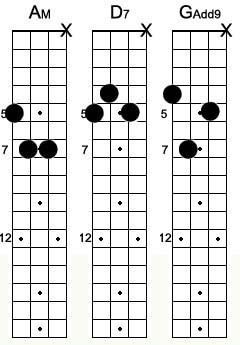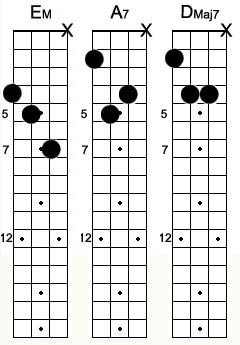« January 2013 |
Main
| March 2013 »
 February 28, 2013 | Tasty Major landing chords
February 28, 2013 | Tasty Major landing chords
Last week we looked at some stock 'ii V7 I' chord blocks. We mentioned potential confusion in past versions of these with chord extension qualities and character, noting we wanted to streamline these. There's nothing wrong with going with just a 3-voice triad, sometimes simpler is better.
Let's revisit these stock positions and add a little flavor this time. Even if you're not into the theory, have some fun and just PLAY the chords!
The original chart can be downloaded here, if you don't have it already.
Download PDF:  Major 'ii V7 I' Blocks Major 'ii V7 I' Blocks

Our first option is to take a CMaj7 and spice it up with an Add9. You could also call it a CMaj9, depending on what other instruments are playing, but we've left the 7th (B) out of the label. Both function as our "landing" tonic chord:

We'll do the same with the G Major block. G Add9. Lovely sound!

As we mentioned, sometimes a simple triad is all you need. Want to give it some character, you can give the landing D major triad its 7th (C#) for an enriching DMaj7. Note, with the root D missing, the block sounds better in the context of an ensemble with another instrument voicing the missing voice. However, if you've established the "D-ness" in chord melody fashion, it will work solo, too.

We'll do the same for our Bb Major set, only we'll give it a Texas Swing taste with a Bb6 chord:

Again, move these around to different keys and employ them in new ways. You want to ingrain the chord movement into your fingers, not just the individual chords.
Further
Major 'ii V7 I' 3-note Mandolin Chord Blocks
ii V7 I Home Positions
Vamps. Expanding the Diatonic triads
Chord economy
7th Chord Streams. Under the hood
Posted by Ted at 9:08 AM
 February 21, 2013 | Major 'ii7 V7 I' 3-note Mandolin Chord Blocks
February 21, 2013 | Major 'ii7 V7 I' 3-note Mandolin Chord Blocks
 A chocolate cake can take many incarnations. Devil's Food, Tiramisu, German Chocolate, these are all variations on a food that functions as a dessert, more specifically a chocolate cake. Arguably, the context dictates which of these is more appropriate in a meal, as an example, the liqueur of the Tiramisu would make it inappropriate for a children's party, the Devil's Food might not be exotic enough in the final course of a fancy French restaurant meal. That's not to say one is better than another, it just needs to fit within the context of function. A chocolate cake can take many incarnations. Devil's Food, Tiramisu, German Chocolate, these are all variations on a food that functions as a dessert, more specifically a chocolate cake. Arguably, the context dictates which of these is more appropriate in a meal, as an example, the liqueur of the Tiramisu would make it inappropriate for a children's party, the Devil's Food might not be exotic enough in the final course of a fancy French restaurant meal. That's not to say one is better than another, it just needs to fit within the context of function.
We bring this up because many have looked at our Stock 'ii V7 I' blocks in our past resource pages as confusing. We interchange an Fm7 with an Fm9 (ii7), a C Maj7 with a C6/9, and it's not because we're haphazard. We just think generically in terms of function, and the music theory novice that's just now learning chord spellings would be thrown off by anything outside the line.
The Maj6 chord is standard in the Texas swing vocabulary, a little campy in jazz fusion. The Maj7 is great for ballad and the Great American Songbook list, but completely out of place in the seriously austere world of modal jazz.
Realtors say "Location. Location. Location. Jazzers say "Context. Context. Context."

We'll start this new look at Major 'ii7 V7 I' 3-note Chord Blocks with all this in mind. We don't want to worry about complex extensions just yet. We may look at variations on down the line, but if we're only going to express three of the voices in a hypothetical six note chord, it's moot anyway.
We've run 7th chord blocks in Major and Minor, introduced streams of these with connecting chords, and recently, some 'I vi ii7 V7' blocks, too. Hopefully, you've already run across them (see links below), but if not, this is as good a place as any to jump on board with 3-note chords. Again, these voicings are great in the lower three strings for tone color and power, and we like to keep the E string free for chord extensions, and voice leading in chord melody playing.
3-note chords. Harmonically complete, sonically sound.
This week we introduce four variations of the simple 'ii V7 I' pattern. Have some fun with them, and immediately start moving them up and down the fretboard into other keys. Start with just two frets (a whole step), try them in between that, and beyond. Once in your fingers, you'll be able to employ them in every jazz standard ever written.
Important Chords!!
Download PDF:  Major 'ii7 V7 I' Blocks Major 'ii7 V7 I' Blocks

Further
ii V7 I Home Positions
Vamps. Expanding the Diatonic triads
Vamps. Minor modal
Minor 7th Chord Streams
7th Chord Streams. Under the hood
Posted by Ted at 5:33 AM
 February 14, 2013 | Bebop Style Chromatic Approach Notes
February 14, 2013 | Bebop Style Chromatic Approach Notes
We recently had the unique privilege publishing an interview with Seattle mandolin/fiddler Pete Martin on the Mandolin Cafe website. We've already introduced some of his materials here, and have been a huge fan of his writing (and playing) for years, including a regular column at Mandolin Magazine. We've invited him to weigh in with some of his lesson materials, so expect similar helpful instruction throughout the year.
If you haven't already purchased one of his books, now's a good time to start. If you'd be interested in personal Skype lessons, contact him for more information on that, too!

Bebop Style Chromatic Approach Notes
Pete Martin
One of the differences in Swing and Bebop era improvisation is how the player uses chord tones and how they approach these chord tones. If you are a swing player and want to 'modernize" your sound, here is one way to updated your soloing.
Example 1 is a typical swing line that uses a lot of notes of the chord. The notes of the G Major 7th chord are G B D and F#. We see all of these notes in a syncopated rhythm in the line in example 1.

Bebop players use "target notes" (usually chord tones) and approach these targets chromatically and by using "surrounds" (playing notes above and below before the target).
To see the difference, now play Example 2.

In example 2 the first target is the note B (the 3rd of a G Major 7th chord). We start above the target by going down the scale, then "surround" the target by going under it to A, then playing upward chromatically (D, C, A, Bb, then the target B).
The next target note is G. The previous target note, B, is the first note of the next approach and surround. B, then under the target to F#, then back above the target to A, then chromatically descending to the target G (B, F#, A, Ab and then the target G).
The last target note is B. This line surrounds the target by preceding it one scale note below (A) and one scale note above (C) before the target (B).
You will find this type of playing in the lines of Charlie Parker, Dizzy Gillespie and especially in the playing of Clifford Brown, who probably took this idea farther than anyone else.
Add these surrounds and chromatic approaches into your playing and see how much jazzier your playing sounds. Anyone interested in further study of this topic can look at my book "Bebop Mandolin: Target Notes and Chromatic Approaches". You can download it free at my web site, www.petimarpress.com
Read article: The Pete Martin Interview
Petimar Press Books and Materials
Posted by Ted at 5:25 AM
 February 7, 2013 | Voice-leading swing chords and extensions with Brian Oberlin
February 7, 2013 | Voice-leading swing chords and extensions with Brian Oberlin
For this week's Tips and Tricks article, we have a special treat. We've asked guest columnist and Oregon clinician, Brian Oberlin to weigh in periodically with some of his pearls of wisdom this year. In addition to his Pacific Northwest teaching and playing schedule, Brian coordinates the prestigious River of the West Mandolin Camp, one of the finest mandolin workshops in the world. We look forward to more in the future!
Voice-leading swing chords and extensions; Brian Oberlin
Download song (two pages): Carbondale PDF

Audio link:  Carbondale MP3 Carbondale MP3
"Carbondale" is a swing song I wrote in 2004 while on tour in Colorado and the chord progression is pretty standard as most early swing music goes. For me, the interesting parts of this song are the lyrics and the chords, and this chart explains the rigors of playing swing mandolin accompaniment. One listen to this song (which is posted on my website), and you will hear the "Stay All Night" feeling I tried to achieve.
There are many different types of inversions and chord extensions in this transcription; too many to notate, in fact, so I have listed the "bare bones" chords in bigger text while a portion of the extended chords are notated in smaller text. In swing, it is very common to approach a chord from a half-step below. It adds a lilt to the rhythm and sounds like you're working a lot harder than you actually are. This can be seen in beat 4 of measure 8: the half-step slide into a D7.
The pinky plays a major role in creating chord extensions as in measures 9, 14, 19, 21, 23, 25, 28, 31, and 33. These chords (9, 13 and #5) are easily played with the pinkie and, again, make it sound like you're working hard.
I am a big fan of descending lines over the same chord, and you can see this in measures 10, 15, 16, 25, and 26. You will need to switch your fingers around to achieve these voice-leading passages. This chart is typical of what I might play during one of the verses. For the other two verses, I will take a different route rhythmically and/or create different motifs within the progression as in measures 21-24.
Any questions or for the other verses, please email me. - Brian Oberlin
www.mandoberlin.com
Camp information: 2013 River of the West Mandolin Camp
June 6 - 9, 2013

Columbia River Gorge, 20 miles east of Portland, Oregon
Posted by Ted at 6:16 AM

Disclaimer: In the 'Information Age' of the 21st Century,
any fool with a computer, a modem, and an idea can
become a self-professed 'expert." This site does not
come equipped with 'discernment.'
|



